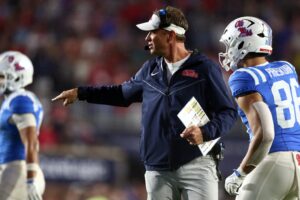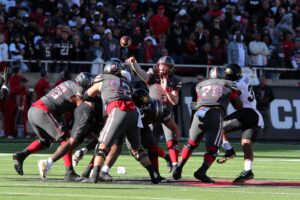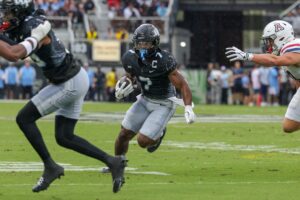Recently, West Virginia fans have circled wagons around the idea that the Mountaineers do a poor job at recruiting in-state talent. Unfortunately, in the era of social media, we can be quick to rally around an idea without determining its merit first. The concept that West Virginia fares poorly at attracting in-state recruits is one such idea. Therefore, we present a detailed look at the truth about in-state recruiting in West Virginia since Head Coach Dana Holgorsen’s arrival.
The Method
As we wrote here, there is a direct correlation between the highest levels of success in big-time college football and the level of talent a school attracts. While recruiting an abundance of highly-ranked talent, without more, does not necessarily lead a team to victories, the absence of highly-ranked recruits does indeed limit the opportunities for success.
As a result, when evaluating recruits, we generally look at players earning three-star rankings or above as those most likely to earn a scholarship at a school in a Power Five Conference. When looking at West Virginia’s in-state prep talent since Holgorsen’s first recruiting class, we, therefore, look exclusively at this level and above.
When examining this talent, we look at each recruiting class year, identify the prospect by composite score (from the 247Sports database), and identify the eventual school to which each prospect committed. Names are excluded to avoid implications about the players, positive or negative. Where a player did not sign a letter of intent with a Power Five school, the prospect is italicized.
The Results
The following chart identifies each of the recruits from the state of West Virginia beginning with the 2012 recruiting class and continuing through the 2018 recruiting class.
| Class Year | Composite Score | School |
| 2018 | .9467 | WVU |
| 2018 | .8368 | WVU |
| 2018 | .8143 | Toledo |
| 2017 | .8840 | UNC |
| 2017 | .8721 | WVU |
| 2017 | .8610 | Tennessee |
| 2017 | .8539 | LSU |
| 2017 | .8510 | WVU |
| 2017 | .8488 | Louisville |
| 2017 | .8249 | WVU |
| 2016 | .8261 | N/A |
| 2016 | .8243 | WVU |
| 2016 | .8111 | N/A |
| 2016 | .8106 | WVU |
| 2015 | .8705 | WVU |
| 2015 | .8413 | Maryland |
| 2015 | .8191 | WVU |
| 2014 | .8371 | WVU |
| 2013 | .8706 | UNC |
| 2013 | .8098 | WVU |
| 2013 | .7993 | Charlotte |
| 2012 | .8109 | Iowa |
West Virginia has produced a total of 22 players that have earned a composite score of 3-stars or above since the 2012 recruiting class.
The next chart breaks the totals into two categories. The first shows the number and percentage of recruits earning the requisite composite score that have committed to West Virginia. The second shows the number of those recruits who ultimately committed to a Power Five program that committed to West Virginia.
| Total to WVU | Total P-5 Players to WVU |
| 11/22 | 11/18 |
| 50% | 61% |
Since Holgorsen arrived in Morgantown, the West Virginia Mountaineers have successfully recruited 11 (or 50%) of the 3-star or above prep recruits that played high school football in West Virginia. For those who committed to Power Five programs, the Mountaineers successfully recruited 11 of the 18 (or 61%).
Those numbers alone suggest that West Virginia does a much better job than some suggest at identifying and successfully recruiting players from West Virginia that may succeed at the Power Five level. That does not, of course, mean that West Virginia has never misjudged talent or failed to attract it. Clearly, it has. But these numbers align favorably with the numbers in other states.
Other States’ Results
For example, Ohio produces an average of about 80 recruits per year that meet or exceed the 3-star threshold. Of those 80, just over 50% of them commit to a Power Five program. And only 5 to 8% of this caliber player commit to Ohio State in an average year. Of the Power Five commits, between 12 and 15% commit to Ohio State.
Alabama produces roughly the same number of 3-star or better recruits per year as Ohio does, and just under half of those recruits ultimately commit to a Power Five program. Of the total, between 12 and 15% commit to either Alabama or Auburn, and, of the Power Five commits, between 25 and 28% commit to one of those two schools.
Oklahoma, on the other hand, produces an average of about 30 recruits per year meeting the 3-star threshold, and just over 65% of those recruits commit to a Power Five program. Of the total, between 42 and 45% commit to either Oklahoma or Oklahoma State. Of the Power Five commits, between 56 and 60% commit to one of those schools.
Like Oklahoma, Arizona produces around thirty 3-star or better recruits per year. Similarly, like Oklahoma, just over 65% of those Arizona prep recruits commit to a Power Five program. But Arizona recruits favor their in-state universities far less, with only 25% of the total going to either Arizona or Arizona State and only 40% of the Power Five commits attending one of those schools.
The Truth about In-State Recruiting in West Virginia
West Virginia historically has produced few 3-star recruits. Nonetheless, over 80% of its 3-star or better recruits sign letters of intent with Power Five schools. And the Mountaineers have largely been responsible for this by signing over 60% of the Power Five commitments. As demonstrated, this number compares favorably to other states.
Indeed, West Virginia continues to grow as a football state. Its prep talent is finally being recognized nationally in larger numbers. As more of that talent succeeds in Power Five programs, whether at West Virginia or elsewhere, the next group of home-grown athletes are given closer looks by scouts. And the prep athletes benefit from this exposure.
Through this cycle, however, West Virginia has missed on some of that in-state talent. And as the talent pool has grown, West Virginia has upset some families and fans by looking over some in-state talent. As the in-state talent grows, that will happen more often.
From the Mountaineers’ perspective, recent recruiting rule changes create an increasingly complex numbers game. The Mountaineers must maintain depth and build and perpetuate enough pipelines to feed sufficient talent into the program. If it fails at either function, fans will call for heads. As that process plays out, however, fans should recognize that they cannot have it both ways. For West Virginia to be a big program, it must act like one. And that means it will sometimes ignore solid in-state talent.
Similarly, as the state itself offers more high-level prep talent, the Mountaineers will miss on more of those players. And that fact, simply, speaks well both of the caliber of West Virginia’s in-state prep talent and of the quality of the flagship’s football program.
Photo Credit:







